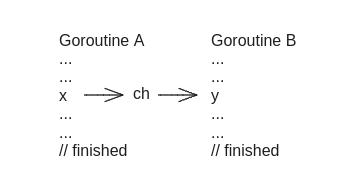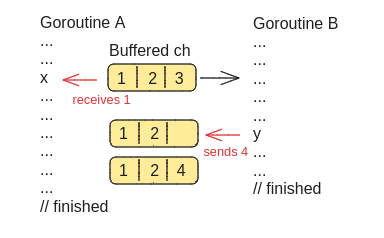
Exploring Go: Channels
As a modern programming language, Go supports concurrent data transfer using a mechanism called channels. This may be new for anyone unfamiliar with Golang, so let’s dive into it!
Goroutines and how to spawn them
We can imagine a goroutine as a sequence of commands. It can be a calculation, or a command to spawn another sequence of commands. A Go runtime independently manages goroutines so they run alternately. That means that a goroutine doesn’t have to wait for another goroutine to finish its sequence of commands if it is not intended. However, we cannot tell which goroutine execution finishes first.
Let’s take a look at this code. Go Playground
package main
import "fmt"
func A() {
fmt.Println("A")
}
func main() {
go A()
fmt.Println("Main")
}
There are three possible outputs: Main followed by A, A followed by Main, and Main only.
Here is what happened: main() itself is a goroutine–we can call it “main goroutine”. It is a sequence of two commands: spawn new goroutine A() and print Main. New goroutine A() prints A, but we cannot tell which goroutine finishes first. If main() finishes first, the runtime finishes and all goroutines are killed. If A() finishes first, main() may continue executing without exiting the runtime.
To spawn a new goroutine, we use go followed by a function call.
1. Sync Goroutines with Channel
To make goroutines useful, we may want to make them communicate with each other. To do that, we can use a channel.
This sample program shows a simple channel implementation. Go Playground.
package main
import (
"fmt"
"time"
)
func A(ch chan int) {
x := <-ch
fmt.Println(x)
}
func B(ch chan int) {
y := 5
ch <- y
}
func main() {
ch := make(chan int)
go A(ch)
go B(ch)
time.Sleep(time.Second)
}
Here we have A() receives 5 from B() through a channel ch. To make a new channel, we use make(chan <data-type>) with any data type or struct. This program prints 5 as long as main() is not finished before A() and B() (we use time.Sleep as a trick).

Note that A’s execution is blocked until ch finds a sender (which is from goroutine B), and so is B blocked until ch finds a receiver. That means print operation will always be done after x receives value from ch.
Try to swap go B(ch) so it comes before go A(ch) and we will have the same result. Again, we cannot tell which goroutine (A or B) finishes its execution first.
2. Buffered channel
This is a common mistake when spawning a Goroutine. Take a look at this example. Go Playground
package main
import (
"fmt"
"time"
)
func A(ch chan int) {
x := <-ch
fmt.Println(x)
}
func main() {
ch := make(chan int)
ch <- 3
go A(ch)
time.Sleep(time.Second)
}
Here we send 3 through a channel, but we never call the receiver. It is because the statement ch <- 3 actually blocks the main() operation, so the program never reaches go A(). If we run this program, we will get the following error.
fatal error: all goroutines are asleep - deadlock!
goroutine 1 [chan send]:
main.main()
/tmp/sandbox1789620925/prog.go:15 +0x2d
Program exited.
Here Go runtime detects that there are no goroutines ready to receive value from ch, so the sender goroutine deadlocks.
There are two ways to solve this problem. One is to simply swap go A() execution before ch <- 3 so A() will receive the value through the channel.
Two, we can actually store the value in a channel. To do that, we need a buffered channel.
This example shows how it works. Go Playground
package main
import (
"fmt"
"time"
)
func A(ch chan int) {
x := <-ch
fmt.Println(x)
}
func main() {
ch := make(chan int, 1)
ch <- 3
go A(ch)
time.Sleep(time.Second)
}
Now we have 3 stored temporarily in ch so it won’t block the next operation (spawning new goroutine A). A then receives from ch, frees up ch memory spaces, and print the value.
Another example of a buffered channel: Go Playground
package main
import (
"fmt"
"time"
)
func A(ch chan string) {
x := <-ch
fmt.Println(x)
x = <-ch
fmt.Println(x)
}
func B(ch chan string) {
ch <- "Alice"
ch <- "Bob"
}
func main() {
ch := make(chan string, 2)
go A(ch)
go B(ch)
time.Sleep(time.Second)
}
To define a buffered channel, we use make with buffer size as the second parameter. In this example, we create a string channel ch with size 2. Then, ch stores both Alice and Bob string before it is released by receiver A(). The output of this program is Alice followed by Bob.
As an exercise, try to modify this code to make avoid possible deadlocks.
package main
import (
"fmt"
"time"
)
func A(ch chan string) {
ch <- "Foo"
ch <- "Bar"
fmt.Println(<-ch)
fmt.Println(<-ch)
}
func main() {
ch := make(chan string)
go A(ch)
go A(ch)
time.Sleep(time.Second)
}
A buffered channel blocks send operations when the buffer is full and blocks receive operations when the buffer is empty. To avoid deadlocks, we want to make a channel with enough capacity until any receive operation fmt.Println is reached.

3. Channel and Select
Try to run this program!
package main
import (
"fmt"
"time"
)
func A(ch chan string) {
time.Sleep(5 * time.Second)
ch <- "A Done"
}
func B(ch chan string) {
ch <- "B Done"
}
func main() {
ch1 := make(chan string)
ch2 := make(chan string)
go A(ch1)
go B(ch2)
fmt.Println(<-ch1)
fmt.Println(<-ch2)
}
The output of this program is always Done A followed by Done B. Here we spawn two goroutines. However, fmt.Println(<-ch1) always blocks the next operations, even if it consumes a significant amount of time.
We can improve this. Because we cannot exactly know which goroutine finishes first, we can use select statement to process whatever channel receives a value. Go Playground
package main
import (
"fmt"
"time"
)
func A(ch chan string) {
time.Sleep(5 * time.Second)
ch <- "A Done"
}
func B(ch chan string) {
ch <- "B Done"
}
func main() {
ch1 := make(chan string)
ch2 := make(chan string)
go A(ch1)
go B(ch2)
for range 2 {
select {
case x := <-ch1:
fmt.Println(x)
case y := <-ch2:
fmt.Println(y)
}
}
}
The output may be B Done followed by A Done after a while. Here we can process any channel that finishes first without waiting for each other.
4. Channel with Timeout
In the previous examples, we have used time.Sleep to delay a goroutine’s execution. We can set a timeout to avoid waiting for data transfer too long.
For example, we can modify the above code to terminate the operation after 3 seconds. Note that we can utilize an infinite for loop and don’t need to use range anymore. Go Playground
package main
import (
"fmt"
"time"
)
func A(ch chan string) {
time.Sleep(5 * time.Second)
ch <- "A Done"
}
func B(ch chan string) {
ch <- "B Done"
}
func main() {
ch1 := make(chan string)
ch2 := make(chan string)
go A(ch1)
go B(ch2)
for {
select {
case x := <-ch1:
fmt.Println(x)
case y := <-ch2:
fmt.Println(y)
case <-time.After(3 * time.Second):
fmt.Println("Timeout")
return
}
}
}
Now we may have B Done followed by Timeout. We didn’t see operations taking too much time.
5. Channel with Close
We can explicitly close a channel if it is not needed anymore. Try to run this!
package main
import "fmt"
func A(ch chan int) {
for i := range 10 {
ch <- i
}
}
func main() {
ch := make(chan int)
go A(ch)
for i := range ch {
fmt.Println(i)
}
}
Here we iterate over a channel using for...range. However, this code results in a deadlock, because main() routine keeps waiting for a value from the channel, whose sender stops after 10 times.
In this case, we need to explicitly close the channel so it won’t send data anymore. Go Playground
package main
import "fmt"
func A(ch chan int) {
for i := range 10 {
ch <- i
}
close(ch)
}
func main() {
ch := make(chan int)
go A(ch)
for i := range ch {
fmt.Println(i)
}
}
Additional: Explanation of the solution
In the problem above, we need to declare a buffered channel with a size of at least 3.
-
If we use an unbuffered channel or a buffered channel with size 1, it will certainly deadlock, because we cannot get into the second statement
ch <- "Bar"of any goroutines a with full buffer. -
If we use a buffered channed with size 2, it may deadlock when the first two strings stored are
Foofrom both goroutines.
Comments
Use a GitHub account to create a comment. This page can be used to edit or delete comments.